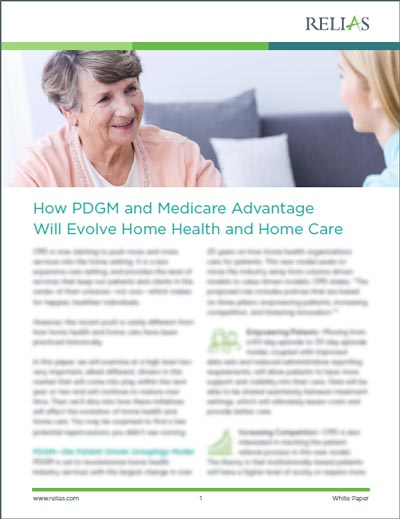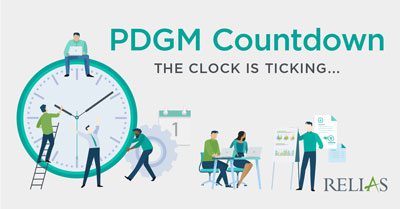WHAT IS PDGM?
The Patient Driven Groupings Model is a case-mix classification model for home health organizations. The model took effect January 1, 2020 and is the largest change to the reimbursement system in nearly 20 years. The goal of PDGM is to get organizations to focus more heavily on the clinical characteristics of the patients they are serving and eliminate the use of therapy service thresholds.
HOME HEALTH AGENCIES ADAPTING TO PDGM
Now that the Patient-Driven Groupings Model has taken effect, home health agencies across the country are trying to keep up and maintain compliance.
The largest change facing home health agencies in over two decades has many organizations evaluating and updating internal processes. Others are expanding their service lines to serve more clinically complex patients.
PDGM is leading to shifts in the way many agencies operate so they can maximize reimbursements under the new model. It can take time to hire new people or train current staff to provide high-quality care for these new types of cases.
To stay compliant with the model, your organization must have a plan for how you will provide care in the years to come.
Do you have the tools you need to thrive as regulations continue to evolve? If the answer is no, Relias has compiled a list of resources to keep you up-to-date on PDGM.
PDGM WEBINARS
PDGM: Lessons Learned from 2020
Join the dialogue in our webinar with William Dombi, President at National Association for Home Care & Hospice (NAHC) and Chris Attaya, Vice President, Product Strategy at Strategic Healthcare Programs. Together they will dive deep into the data, discuss lessons learned, and postulate what organizations can do to thrive going forward.
Learn MorePDGM: What We’ve Learned So Far
With the Patient-Driven Groupings Model now in effect, many agencies are wondering what the new normal looks like across the industry.
Learn MoreHome Care and Hospice Regulatory Update 2020
Watch NAHC President, William A. Dombi, reflect on the current status of home care and hospice and give a prognosis of the future.
Learn MorePDGM’s Impact on Billing & Finance
Watch this webinar to learn how PDGM will impact the operations of your billing department and learn which components will have the most significant impact on your revenue.
Learn MoreThe 90-Day Plan: Five Critical Steps to Take Before PDGM Goes Into Effect
Discover the 5 critical steps to PDGM success as well as concrete examples of how agencies can successfully navigate this change.
Learn MoreAn Overview of PDGM: Preparing for 2020
Get an overview of the PDGM structure and operation along with a review of the concerns and opportunities triggered by PDGM.
Learn MoreADDITIONAL PDGM RESOURCES

How PDGM and Medicare Advantage Will Evolve Home Health and Home Care
Download this white paper to learn how to leverage the new technology demands of PDGM and analyze your case mix to prepare for change.
Download the White PaperOASIS Simulation: Assessing at the Start of Care
This simulation will guide learners through scenarios designed to provide an opportunity to practice analyzing patient assessment data for OASIS-D items.
Learn MorePDGM Operations: Clinical
Created in partnership with BlackTree Healthcare Consulting, this course will help you understand how specific areas of clinical operations will be impacted under PDGM.
Learn MoreHELPFUL PDGM BLOG POSTS
PDGM Best Practices: Ensure Smooth Claims Processing in Home Health
A year after the Patient-Driven Groupings Model took effect, we can identify some best practices for home health reimbursements. Details count with PDGM, so pay attention.
Learn MoreWorried About the Financial Impact of PDGM? Do Your Homework!
Many home health officials are worried that PDGM will not be budget neutral and that the new reimbursement strategy could lead to shaky financial standing.
Learn MoreNew Regulations and Renewed Risks in Senior Care
Taking purposeful steps to train your staff on person-centered care will not only prevent abuse and neglect, but it will also position your organization for success as upcoming regulation changes begin to take effect.
Learn MoreIn Our Evolving PDPM/PDGM World, Could Adding a Specialty Be a Game Changer?
Adding a specialty to your repertoire in order to have more control, provide better outcomes, and work within the playbook you’ve been given will be the matter at hand in a growing PDPM world.
Learn MoreTop Questions About PDGM’s Impact on Billing & Finance Answered
See the answers to the most frequently asked billing and finance questions regarding the Patient Driven Groupings Model.
Learn MorePDGM FREQUENTLY ASKED QUESTIONS
-
When did PDGM go into effect?
The Patient Driven Groupings Model took effect January 1, 2020.
-
What is a Behavioral Adjustment?
When CMS makes changes in policy, they assume that the behavior of home health organizations will change in an attempt to maximize reimbursements.
CMS sees this as a problem because they want organizations to treat the patient, instead of trying prescribe a treatment that will maximize dollars. To take a proactive stance against this behavior, CMS reduces the amount of money given for certain reimbursements.
-
What is the Behavioral Adjustment for PDGM?
CMS announced that the final behavior change adjustment for PDGM 30-day payment rates would be a 4.36% reduction instead of the proposed 8.01% decline.
-
Why is the Behavioral Adjustment Controversial?
Many home health advocates do not like the idea of creating a behavioral adjustment before new regulations take effect.
The believe that CMS should not base adjustments on assumed behavior changes in response to PDGM’s implementation but rather on actual behavioral changes.
-
When questionable encounters are discussed, does this refer to when these codes are included with other codes or only on their own?
Questionable Encounters (QE) refer specifically to the primary diagnosis on the claim. Diagnosis codes that would qualify as a QE in the primary diagnosis spot can be listed as a subsequent diagnosis on the claim. The main concept here is that these diagnoses represent a symptom of the patient’s condition but on their own do not constitute home health eligibility.
-
How will PDGM impact MSP?
The general concepts of medicare secondary payer (MSP) billing will remain the same under PDGM. Providers will have to adapt the use of the existing MSP billing codes to the new PDGM claim format.
-
Will CMS be paying requests for anticipated payment in a timely way so that an agency can process billing promptly for the 30-day final claim?
There has been no indication that the processing time for RAPs (typically four to five days) will change under PDGM. We recommend, however, that providers monitor processing times over the first couple months of 2020 in case the RAP processing time is impacted by updates made to the Medicare system for PDGM.
-
Why will it take three to four months for the cash flow to return to normal?
The projected cash flow delay is impacted by a few issues. First, it is anticipated that adapting to the new PDGM system will result in billing delays for providers due to the shortened timeframe for resolving prebilling issues and limitations in the EMR PDGM setup. Historically, Medicare has also shown delays in claims processing when making system updates of a much smaller magnitude than PDGM. It is not guaranteed that this will occur during the PDGM implementation, but providers should be aware of the potential delays. Finally, National Association for Home Care & Hospice (NAHC) performed an independent review using example cases for PDGM periods starting on various dates. This analysis found that in most cases agency cash flow would not return to pre-PDGM levels until approximately March 2020. The impact will be different for each provider, but our recommendation is that providers prepare for this potential risk.
-
How is PDGM going to affect agencies who have "therapy only" patients?
The decision-making on discipline/visit utilization should not change under PDGM. The plan of care should still be designed to meet the service needs of the patient. If this dictates that the patient only needs therapy services, then the service delivery should not be different than it was under PPS. Providers will have to evaluate, however, the anticipated change in revenue for this service category under PDGM compared to the Prospective Payment System. We also recommend that providers evaluate their patient mix as a whole to determine if it is sustainable under PDGM, especially if this patient mix involves a high therapy need.









